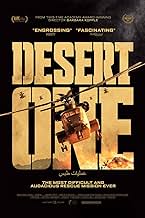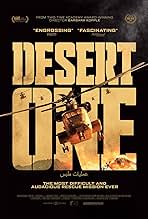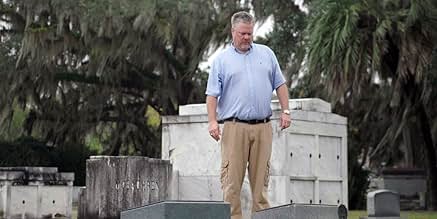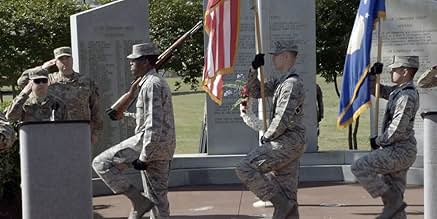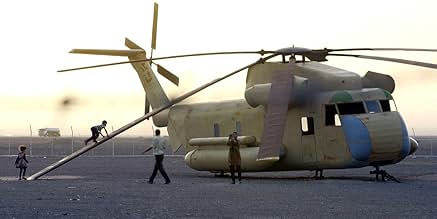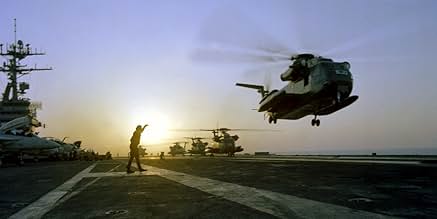Adicionar um enredo no seu idiomaUsing new archival sources and unprecedented access, master documentarian Barbara Kopple reveals the story behind one of the most daring rescues in modern US history: a secret mission to fre... Ler tudoUsing new archival sources and unprecedented access, master documentarian Barbara Kopple reveals the story behind one of the most daring rescues in modern US history: a secret mission to free hostages of the 1979 Iranian revolution.Using new archival sources and unprecedented access, master documentarian Barbara Kopple reveals the story behind one of the most daring rescues in modern US history: a secret mission to free hostages of the 1979 Iranian revolution.
- Direção
- Roteirista
- Artistas
- Prêmios
- 1 indicação no total
- Self - U.S. Army
- (as Maj James O. Roberts)
- Self - Deputy to Chairman, Joint Chiefs of Staff
- (as LTG John Putsay)
- Self - U.S. Air Force
- (as TSgt Kenneth Bancroft)
- Self - Delta Force
- (as Maj Lewis "Bucky" Burruss)
- Self - Delta Force
- (as Maj William G. Boykin)
- Self - U.S. Marine Corps
- (as SSgt Bucky Buchanan)
- Self - U.S. Marine Corps
- (as GySgt John Sigman)
- Self - U.S. Marine Corps
- (as Col Ed Seiffert)
Avaliações em destaque
Sad to whitewash history when you have the chance to tell the truth.
From Esquire : What happened next Mr. Barnes has largely kept secret for nearly 43 years. Mr. Connally, he said, took him to one Middle Eastern capital after another that summer, meeting with a host of regional leaders to deliver a blunt message to be passed to Iran: Don't release the hostages before the election. Mr. Reagan will win and give you a better deal. Then shortly after returning home, Mr. Barnes said, Mr. Connally reported to William J. Casey, the chairman of Mr. Reagan's campaign and later director of the Central Intelligence Agency, briefing him about the trip in an airport lounge.
Mr. Barnes identified four living people he said he had confided in over the years: Mark K. Updegrove, president of the L. B. J. Foundation; Tom Johnson, a former aide to Lyndon Johnson (no relation) who later became publisher of the Los Angeles Times and president of CNN; Larry Temple, a former aide to Mr. Connally and Lyndon Johnson; and H. W. Brands, a University of Texas historian. All four of them confirmed in recent days that Mr. Barnes shared the story with them years ago. "As far as I know, Ben never has lied to me," Tom Johnson said, a sentiment the others echoed. Mr. Brands included three paragraphs about Mr. Barnes's recollections in a 2015 biography of Mr. Reagan, but the account generated little public notice at the time.
It is said that success has many parents but failure is always an orphan. Desert One presents an obvious example of just how true this statement is. As the documentary recalls one unforeseen and surprising event after another---the cumulative effects of which ultimately led to an aborting of the mission--we again are struck by its apparent lack of appropriate readiness and the absence of reliable intelligence that denied us the opportunity to get a more sober assessment of Operation Eagle Claw's chances for a positive outcome.
Desert One unfolds in a sober and riveting way as it tells us the story of this mission, the truly brave men who participated in it and where and how it went wrong. Of course unanswered questions remain. Who were the principal cabinet advisors who counseled President Carter to go ahead with Operation Eagle Claw given all its risks? Why were we so ill prepared to deal with the real conditions encountered on the ground? Could the mission have been aborted sooner based upon the facts experienced at the time?
We come away from seeing Desert One much better informed about this sad episode. That is the hallmark of a good documentary. We should be grateful to all who participated in its creation who enabled us to better understand the facts depicted in Desert One. And when another such dangerous mission does turn out well--like the later taking out of Osama Bin Laden-we should better appreciate the tremendous difficulties heroic Americans needed to overcome to achieve that success.
DESERT ONE, a 2019 documentary directed by Barbara Kopple, the legendary documentary filmmaker responsible for, among many classic docs, 1976's HARLAN COUNTY U. S. A., and 2006's DIXIE CHICKS: SHUT UP AND SING, takes a look at the lead-up to this event, including America's turbulent relationship with Iran, one which went rocky in 1953 when Iran's then-leader, and democratically elected prime minister, Mohammed Mosadegh was overthrown and killed in a violent CIA-sponsored coup. This resulted in the ascension of Reza Pahlavi, the "Shah", to power in Iran, where he was for all intents and purposes a "toady" for the United States. But in 1979, the Shah was overthrown by the Ayatollah Khomeni; and on November 4th of that year, radical students inspired by Khomeni seized the American embassy, holding fifty-two American diplomats hostage. This prompted then-President Jimmy Carter to instigate Operation Eagle Claw. The intent was to hatch a raid seemingly similar to Israel's 1976 Entebbe rescue mission. Its failure, and the deaths of the eight servicemen, dealt a blow to American prestige and morale, prolonged the hostage crisis, doomed Carter's re-election chances in 1980, and led to Ronald Reagan's ascension to the presidency.
In DESERT ONE, we get interviews with both Carter and his vice-president Walter Mondale, as well as interviews with former CIA director Robert Gates; legendary ABC newsman Ted Koppel (whose "Nightline" followed the Tehran hostage crisis from start to finish, and would become a fixture on ABC's late night programming for decades to come); and many of the embassy hostages and surviving members of Operation Eagle Claw (Michael Metrinko; James Q. Roberts; Ed Seiffert), as well as recorded telephone conversations between President Carter and Charles Beckwith, the legendary special forces commander responsible for the creation of Delta Force, of what was happening with the mission as it was unfolding and, unfortunately, fatally unraveling. Much of what emerges from DESERT ONE is the realization that dealing with what we call Middle East radicalism (especially when, in the case of Iran, it's something that our own government foments) and, eventually, terrorism is not nearly as cut-and-dried as we may have wanted to think it was.
But what also emerges is the fact that a group of good men at least had the guts to try and rescue our personnel from the hellhole they found themselves put in by the takeover of the embassy; and they deserve all the credit, the praise, and the commendations from We The People that they can get.
Você sabia?
- Erros de gravaçãoThe occupants of the C130 are looking out of the left-hand paratroop door at the fire; someone closes the door but it slides left to right. The paratroop door opens vertically, so it should slide down to close.
- Citações
Jimmy Carter: Do you have any report on the helicopter's location?
- ConexõesReferences ABC News Nightline (1979)
Principais escolhas
Detalhes
- Data de lançamento
- País de origem
- Central de atendimento oficial
- Idiomas
- Também conhecido como
- Desert One - Gidseldramaet i Teheran
- Locações de filme
- Empresas de produção
- Consulte mais créditos da empresa na IMDbPro
Bilheteria
- Orçamento
- US$ 1.500.000 (estimativa)
- Tempo de duração1 hora 48 minutos
- Cor
Contribua para esta página





